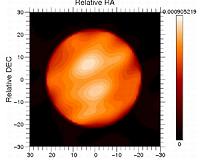 |
Canberra, Australia (SPX) Feb 03, 2011 Using the Parkes radio telescope, CSIRO astronomers are working closely with NASA to unlock one of astronomy's great enigmas - the science behind pulsars. The team are using the world-class facilities at Parkes, in combination with NASA' s Fermi Gamma-Ray Space Telescope, to understand how these small spinning stars make their beams of radiation. The project has tracked down 25 ultrafast 'millisecond' pulsars in just two years - the same number discovered in the previous 20 years. "This has been a hugely productive collaboration, and it is generating unprecedented returns for physics and astronomy," said the leader of the Parkes observations, CSIRO's Dr Simon Johnston. Innovation Minister Senator Kim Carr said the research exemplified the sorts of international collaboration that the Australian Government was fostering across the board. "We have a proud history of cooperation and involvement with NASA on a number of fronts, from assisting with communicating with the Apollo missions to the moon, to deep space exploration, and understanding how our universe works," Senator Carr said. "It's all about exploring new frontiers and building Australian capacity as a research intensive and innovative nation. "While this might seem remote from everyday life, experience has shown that space exploration in all its forms has unforeseen spin-offs that provide wide-reaching benefits through new technologies and new approaches to a range of challenges." The study of pulsars demands highly advanced scientific infrastructure and expertise. Pulsars emit beams of radio waves, gamma waves, or both. Sensitive radio telescopes such as the CSIRO facility at Parkes can detect the radio waves as they sweep across the Earth. But gamma rays - which carry billions of times more energy than the light our eyes can see - are blocked by the Earth's atmosphere. We can only study them using telescopes in space. The CSIRO-NASA collaboration shows we get the best results by combining land and space-based detectors. First, the Fermi space telescope is finding unidentified gamma-ray sources, which the Parkes telescope can investigate for radio wave pulses. "That's how we were able to find those 25 millisecond pulsars, an incredible haul," Dr Johnston said. Second, Parkes is doing very precise timing of 168 radio pulsars that Fermi might be able to study. "We work out exactly when the pulsar's radio beam sweeps over us. That tells us how fast the pulsar is rotating," Dr Johnston said. "That knowledge helps us make use of the gamma-ray photons that Fermi detects. If Parkes can get the timing precisely right through the radio wave pulses, we can build up a picture of the gamma-ray pulses by collecting a few photons every time the pulsar beam sweeps past." The collaboration has thrown up some intriguing results. Of the 60 objects Fermi has found that emit gamma-ray pulses, about twenty lack detectable radio pulses. "The most likely explanation is that these pulsars do have radio beams, but they are just not sweeping across the Earth, so we can't detect them," Dr Johnston said. "In other words, we think the beam of gamma rays is a big fat beam, which is easier to detect, and the radio beam is more tightly directed, less spread out. "This suggests certain things about where on the pulsar the two beams come from, and how they are made. It's only when we work together that we can crack these long-standing mysteries."
Share This Article With Planet Earth
Related Links CSIRO Astronomy and Space Science Stellar Chemistry, The Universe And All Within It
 Second Sun May Appear At Any Moment
Second Sun May Appear At Any MomentMoscow, Russia (RIA Novosti) Feb 01, 2011 Scientists claim that Betelgeuse, a star 640 light years away from Earth, is going to explode soon. Nikolai Chugai, head of the department of Variable Stars and Astronomical Spectroscopy of the Russian Academy of Sciences' Institute of Astronomy shares his views with RIA Novosti's Samir Shakhbaz, on possible threats and impact this star may cause to our planet. Samir Shakhbaz: Good afterno ... read more |
|
| The content herein, unless otherwise known to be public domain, are Copyright 1995-2010 - SpaceDaily. AFP and UPI Wire Stories are copyright Agence France-Presse and United Press International. ESA Portal Reports are copyright European Space Agency. All NASA sourced material is public domain. Additional copyrights may apply in whole or part to other bona fide parties. Advertising does not imply endorsement,agreement or approval of any opinions, statements or information provided by SpaceDaily on any Web page published or hosted by SpaceDaily. Privacy Statement |